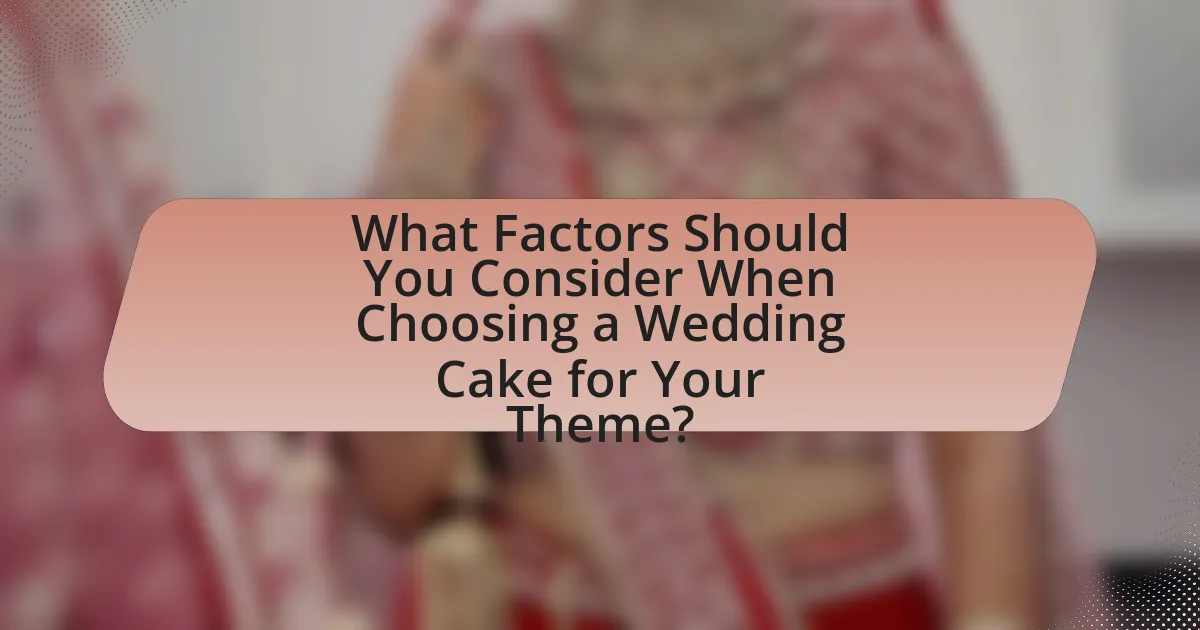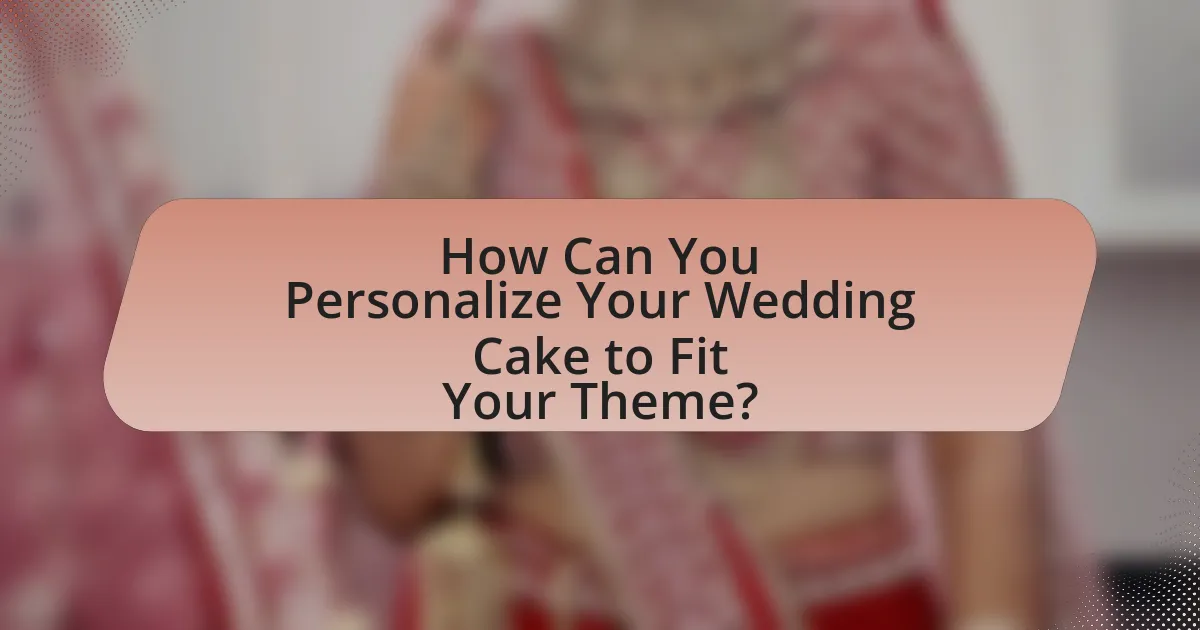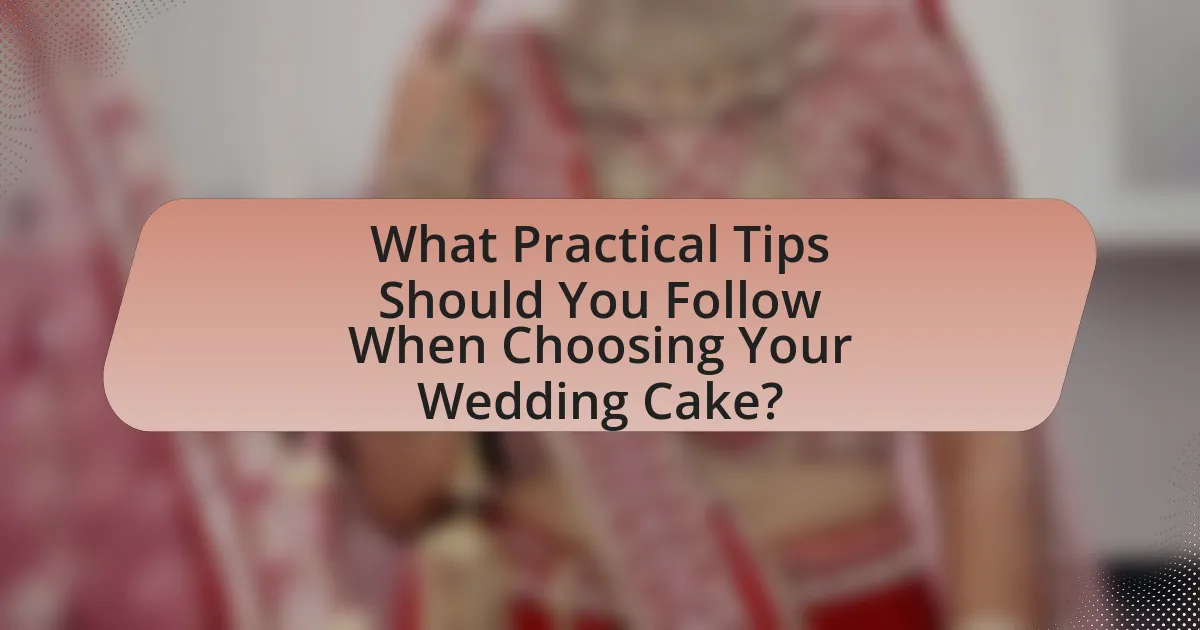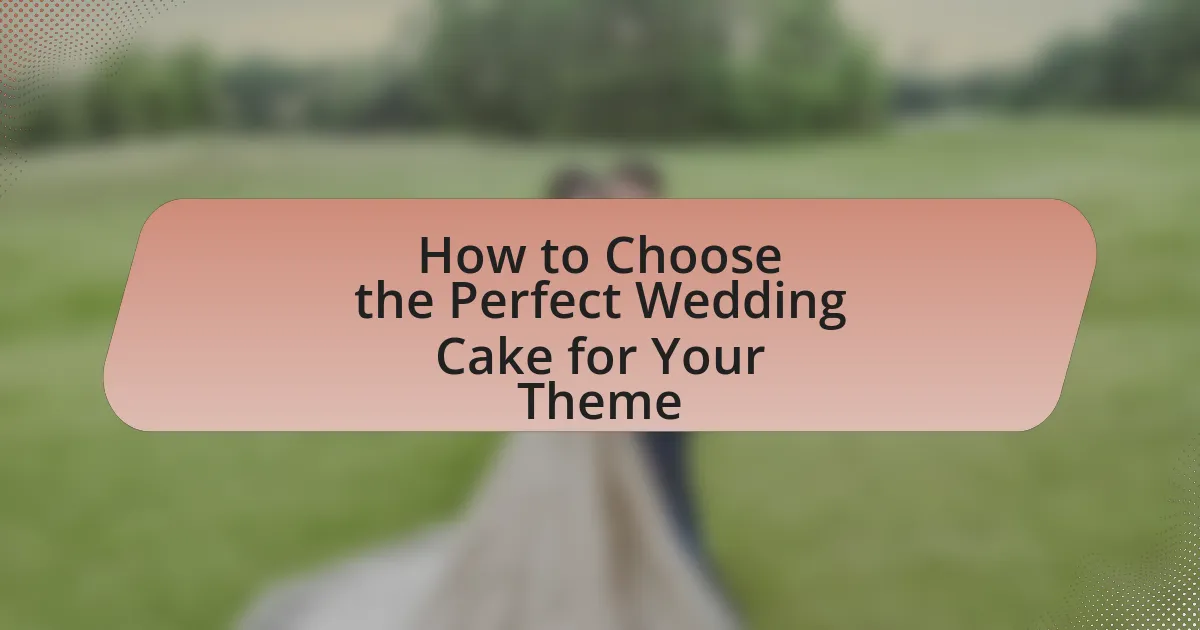Choosing the perfect wedding cake is essential for enhancing the overall theme of the celebration. Key factors to consider include the cake’s design, flavor, and size, all of which should align with the wedding’s aesthetic and guest preferences. The article explores how wedding themes influence cake design, popular styles and flavors, and practical tips for selecting a baker. Additionally, it addresses the importance of personalization through decorative elements and cultural influences, ensuring that the cake not only tastes good but also serves as a meaningful centerpiece of the event.

What Factors Should You Consider When Choosing a Wedding Cake for Your Theme?
When choosing a wedding cake for your theme, consider the cake’s design, flavor, and size. The design should reflect the overall aesthetic of the wedding, such as colors, patterns, and motifs that align with the theme. For example, a rustic wedding may call for a naked cake adorned with fresh flowers, while a formal event might require a multi-tiered cake with intricate fondant details. Flavor is also crucial; it should appeal to the couple and guests, with options ranging from classic vanilla to unique flavors like lavender or chocolate raspberry. Lastly, the size of the cake must accommodate the guest list, ensuring there is enough for everyone while also fitting the venue’s space. These factors collectively ensure that the wedding cake enhances the theme and overall experience of the celebration.
How does your wedding theme influence the cake design?
Your wedding theme significantly influences the cake design by dictating the colors, styles, and overall aesthetic of the cake. For instance, a rustic wedding theme may lead to a cake adorned with natural elements like flowers and wood accents, while a modern theme might favor sleek lines and geometric shapes. The choice of flavors can also reflect the theme; a beach wedding might inspire tropical flavors like coconut or pineapple. According to a survey by The Knot, 70% of couples choose cake designs that align with their wedding theme, demonstrating the strong connection between the two.
What are the key elements of your wedding theme to reflect in the cake?
The key elements of a wedding theme to reflect in the cake include color scheme, style, and motifs. The color scheme should match the overall palette of the wedding, ensuring that the cake complements the decorations and attire. The style of the cake, whether it’s rustic, elegant, or modern, should align with the wedding’s aesthetic. Additionally, motifs such as floral designs, geometric patterns, or cultural symbols can be incorporated to enhance the theme and personalize the cake. These elements collectively ensure that the cake serves as a cohesive part of the wedding celebration.
How can color schemes impact your cake selection?
Color schemes significantly influence cake selection by aligning the cake’s appearance with the overall wedding theme. A well-coordinated color scheme enhances visual harmony, making the cake a focal point that complements the decor. For instance, a pastel color palette can evoke a soft, romantic atmosphere, while bold colors may create a vibrant and energetic vibe. Research indicates that color can affect emotions and perceptions; for example, studies show that colors like blue can induce calmness, while red can stimulate excitement. Therefore, selecting a cake that reflects the chosen color scheme not only enhances aesthetic appeal but also reinforces the desired mood of the wedding celebration.
What are the different styles of wedding cakes available?
Different styles of wedding cakes include traditional, modern, rustic, and themed cakes. Traditional wedding cakes are often multi-tiered and decorated with white icing, symbolizing purity. Modern cakes may feature unique shapes, bold colors, and innovative designs, reflecting contemporary trends. Rustic cakes typically have a more natural appearance, often adorned with fresh flowers or textured icing, appealing to outdoor or country-themed weddings. Themed cakes are customized to reflect the couple’s interests or wedding theme, incorporating specific colors, designs, or elements that tell their story. Each style caters to different aesthetic preferences and wedding themes, ensuring a personalized touch for the celebration.
What are the popular wedding cake styles that match various themes?
Popular wedding cake styles that match various themes include classic tiered cakes, rustic naked cakes, modern geometric cakes, and whimsical themed cakes. Classic tiered cakes, often adorned with fondant or buttercream, suit traditional weddings and can be customized with floral decorations. Rustic naked cakes, characterized by their exposed layers and minimal frosting, align well with outdoor or bohemian themes, emphasizing natural elements. Modern geometric cakes feature clean lines and bold colors, making them ideal for contemporary or minimalist weddings. Whimsical themed cakes, designed to reflect specific interests or hobbies, cater to unique celebrations, such as vintage or fairytale themes. Each style can be tailored to enhance the overall wedding theme, ensuring a cohesive aesthetic.
How do tiered cakes differ from single-layer cakes in theme representation?
Tiered cakes differ from single-layer cakes in theme representation by offering greater versatility and complexity in design. Tiered cakes can incorporate multiple themes across different layers, allowing for a more elaborate visual narrative that can reflect various aspects of a couple’s story or wedding theme. For example, each tier can represent a different color scheme, texture, or motif, enhancing the overall aesthetic and making a stronger thematic statement. In contrast, single-layer cakes typically present a more straightforward design, limiting the ability to convey multiple themes or intricate details. This distinction is significant in wedding planning, as couples often seek cakes that not only taste good but also serve as a focal point that aligns with their overall wedding theme.
What flavors should you consider for your wedding cake?
For your wedding cake, consider flavors such as vanilla, chocolate, red velvet, lemon, and almond. These flavors are popular choices due to their broad appeal and versatility. Vanilla is classic and pairs well with various fillings, while chocolate offers a rich taste that many guests enjoy. Red velvet provides a unique color and flavor profile, making it visually striking. Lemon adds a refreshing citrus note, and almond gives a subtle nuttiness that complements other flavors. These options are frequently chosen for weddings, reflecting both tradition and modern preferences.
How do flavor choices complement the overall wedding theme?
Flavor choices enhance the overall wedding theme by aligning the cake’s taste profile with the event’s aesthetic and emotional tone. For instance, a rustic wedding theme may be complemented by flavors like carrot or spice cake, which evoke a homey, warm feeling, while a modern, elegant theme might be better suited to sophisticated flavors such as chocolate ganache or lemon zest. This alignment not only reinforces the visual elements of the wedding but also creates a cohesive sensory experience for guests, making the event more memorable. Research indicates that flavor preferences can significantly influence guests’ overall satisfaction, thus supporting the idea that thoughtful flavor selection is crucial for thematic coherence.
What are the trending flavors for wedding cakes in 2023?
The trending flavors for wedding cakes in 2023 include classic vanilla, rich chocolate, and unique options like lemon elderflower and red velvet. These flavors have gained popularity due to their versatility and appeal to a wide range of tastes. Additionally, flavor combinations such as salted caramel and chocolate hazelnut are also trending, reflecting a growing preference for indulgent and sophisticated tastes among couples. The rise in these flavors can be attributed to current wedding trends that emphasize personalization and unique culinary experiences.

How Can You Personalize Your Wedding Cake to Fit Your Theme?
To personalize your wedding cake to fit your theme, select design elements that reflect your overall wedding aesthetic, such as colors, shapes, and decorations. For instance, if your theme is rustic, consider a cake with a textured buttercream finish and natural elements like flowers or wood accents. Additionally, incorporating flavors that resonate with your theme, such as seasonal fruits for a summer wedding or rich spices for a fall celebration, enhances the personalization. Research indicates that couples who align their cake design with their wedding theme report higher satisfaction with their overall event experience, emphasizing the importance of cohesive design choices.
What decorative elements can enhance your wedding cake’s theme?
Decorative elements that can enhance your wedding cake’s theme include fondant, edible flowers, cake toppers, and intricate piping designs. Fondant allows for smooth finishes and can be colored or shaped to match the wedding’s color palette and style. Edible flowers, such as roses or orchids, add a natural and elegant touch, complementing floral arrangements used in the wedding. Cake toppers, whether personalized figurines or monograms, provide a focal point that reflects the couple’s personality or theme. Intricate piping designs can mimic lace or other textures, adding depth and sophistication to the cake’s appearance. These elements collectively contribute to a cohesive and visually appealing representation of the wedding theme.
How can floral arrangements be incorporated into your cake design?
Floral arrangements can be incorporated into cake design by using fresh or edible flowers as decorative elements. This method enhances the visual appeal of the cake and aligns with wedding themes that emphasize natural beauty. For instance, using seasonal flowers can create a cohesive look that complements the overall wedding decor. Additionally, edible flowers, such as pansies or violets, can be safely integrated into the cake layers or frosting, providing both aesthetic and flavor benefits. This practice is supported by the trend of incorporating organic and locally sourced ingredients in wedding cakes, which has gained popularity in recent years.
What role do cake toppers play in personalizing your wedding cake?
Cake toppers play a crucial role in personalizing wedding cakes by reflecting the couple’s unique style and story. These decorative elements can range from traditional figurines to custom designs that symbolize shared interests, hobbies, or significant moments in the couple’s relationship. For instance, a couple who loves travel might choose a cake topper featuring a globe or airplane, while another couple might opt for a monogram or initials to signify their union. This personalization not only enhances the visual appeal of the cake but also serves as a meaningful representation of the couple’s identity, making the wedding cake a memorable centerpiece of the celebration.
How can you incorporate cultural elements into your wedding cake?
To incorporate cultural elements into your wedding cake, you can use traditional flavors, designs, and symbols that reflect your heritage. For example, if you have a specific cultural background, you might choose flavors like matcha for Japanese culture, or spices like cardamom for Indian weddings. Additionally, you can decorate the cake with motifs or patterns that are significant in your culture, such as henna designs for South Asian weddings or floral patterns common in Mexican celebrations. These choices not only personalize the cake but also honor your cultural traditions, making the cake a meaningful centerpiece of your celebration.
What are some traditional cake designs from different cultures?
Traditional cake designs from different cultures include the Italian Millefoglie, a layered pastry filled with cream; the Mexican Tres Leches cake, a sponge soaked in three types of milk; and the Japanese Matcha cake, which incorporates green tea for flavor and color. Each of these cakes reflects cultural significance and culinary traditions. For instance, the Millefoglie is often served at celebrations in Italy, symbolizing layers of love and commitment, while the Tres Leches cake is a staple at festive occasions in Mexico, representing richness and indulgence. The Matcha cake, popular in Japan, embodies the country’s appreciation for tea and aesthetics in food presentation.
How can you blend cultural elements with modern cake trends?
To blend cultural elements with modern cake trends, incorporate traditional flavors, designs, and techniques into contemporary cake styles. For instance, using spices like cardamom or saffron in cake recipes can reflect cultural heritage while appealing to modern palates. Additionally, integrating traditional motifs or symbols into sleek, minimalist cake designs can create a visually striking fusion. This approach not only honors cultural significance but also aligns with current aesthetic preferences, as seen in the popularity of fusion cuisine and design in the culinary world.

What Practical Tips Should You Follow When Choosing Your Wedding Cake?
When choosing your wedding cake, prioritize flavor, design, and budget. Selecting a cake that reflects your personal taste and complements your wedding theme is essential. Consider scheduling tastings with multiple bakers to evaluate flavors and textures, as 70% of couples report that taste is the most important factor in their decision. Additionally, discuss design options that align with your wedding’s color scheme and style, ensuring the cake enhances the overall aesthetic. Finally, establish a clear budget early on, as wedding cakes can range from $2 to $12 per slice, depending on complexity and ingredients. This approach will help you make informed decisions that satisfy both your palate and your vision.
How do you select the right baker for your wedding cake?
To select the right baker for your wedding cake, first evaluate their portfolio to ensure their style aligns with your vision. A baker’s previous work showcases their skills, creativity, and ability to execute various designs, which is crucial for a wedding cake that reflects your theme. Additionally, read reviews and testimonials from past clients to gauge their reliability and customer satisfaction. According to a survey by The Knot, 80% of couples consider online reviews essential when choosing wedding vendors, highlighting the importance of this step. Finally, schedule tastings to assess the flavor and quality of the cakes, as taste is as important as appearance in making your final decision.
What questions should you ask potential bakers during consultations?
During consultations with potential bakers, you should ask about their experience with wedding cakes, including how many they have created and their familiarity with various styles and themes. Additionally, inquire about their flavor options, customization capabilities, and whether they can accommodate dietary restrictions. It is also essential to ask about their pricing structure, deposit requirements, and cancellation policies. Lastly, request to see a portfolio of their previous work to assess their design skills and quality. These questions ensure that the baker aligns with your vision and requirements for your wedding cake.
How can you assess a baker’s previous work and reliability?
To assess a baker’s previous work and reliability, review their portfolio of past cakes and customer testimonials. A comprehensive portfolio showcases the baker’s style, creativity, and skill level, while testimonials provide insights into customer satisfaction and reliability. For instance, a baker with a strong online presence, including reviews on platforms like Yelp or Google, often indicates a history of successful deliveries and satisfied clients. Additionally, checking for any awards or recognitions can further validate their expertise in cake design and baking.
What are the common mistakes to avoid when choosing a wedding cake?
Common mistakes to avoid when choosing a wedding cake include not considering the guest count, overlooking flavor preferences, and neglecting the cake’s design compatibility with the wedding theme. Failing to account for the number of guests can lead to insufficient servings, while ignoring flavor preferences may result in a cake that guests do not enjoy. Additionally, selecting a cake design that does not align with the overall wedding theme can create a disjointed aesthetic. According to a survey by The Knot, 70% of couples reported that cake flavor was a significant factor in their decision-making process, highlighting the importance of flavor consideration.
How can you ensure your cake fits within your budget?
To ensure your cake fits within your budget, establish a clear budget limit before selecting a cake. This involves determining the maximum amount you are willing to spend on the cake, which helps narrow down options and prevents overspending. Additionally, consider factors such as the size, complexity, and ingredients of the cake, as these directly influence the cost. For example, a simple design with fewer tiers typically costs less than an elaborate multi-tiered cake. By communicating your budget to the baker, you can receive tailored suggestions that align with your financial constraints, ensuring that the final choice meets both your aesthetic and budgetary needs.
What should you consider regarding cake size and guest count?
When determining cake size, consider the number of guests attending the event. A standard guideline is to allocate one slice of cake per guest, which typically means a cake serving should be designed to accommodate the total guest count. For example, if you have 100 guests, a cake that serves at least 100 slices is necessary to ensure everyone receives a piece. Additionally, factors such as the type of cake, serving style, and whether other desserts will be provided can influence the final size needed. This approach ensures that all guests are satisfied and helps avoid waste.
